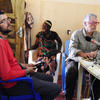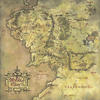You are here
How to speak to extraterrestrials?

You are the author of the Guide to interstellar communication: astrolinguistics, space exploration, science fiction, published in June by the Éditions de l’université Grenoble Alpes. How did you become interested in astrolinguistics?
Frédéric Landragin1. As a linguist, it is a subject that I explored by adopting a popular science approach. I wrote a book entitled Comment parler à un alien ? (How to Speak to an Alien, Éditions du Bélial, 2018), which is an introduction to linguistics for readers who enjoy science fiction. I sought to analyse various references, such as the films Contact and Arrival , through the prism of this discipline. The book had a small measure of success, and I continued my work in astrolinguistics, always doing so as a populariser. It should be pointed out that it is absolutely not a science, but rather the efforts of a few eccentrics around the world. Their work is nevertheless fascinating, because it raises crucial questions such as “What is a language?”, or “Can a universal language exist?”

But why seek to communicate with beings we know nothing about, not even whether they exist?
F. L. This is an essential question for humanity: Are we alone in the Universe? Is there another planet where life developed, or even millions of others? This is a head-spinning question, because it is terrible regardless of the answer. If life exists only on Earth, then we have a tremendous responsibility. If life exists elsewhere, then we are facing something that calls religions into question. In either case, the answer is very difficult to digest. However, this quest has motivated some people to try to send messages to other planets, and to reflect on what form of message could be understood by aliens.
How do you concretely go about speaking to an entity you know nothing about?
F. L. In the early twentieth century, pioneers began by simply trying to signal our presence. They imagined lighting fires in trenches to delineate large signs visible from the Moon or from Mars. They then realized that—without wanting to—we had already signalled our presence via radio and television emissions, which reach distances much further than those explored by the Pioneer and Voyager probes. Since the 1960s, the goal has been to send messages that move beyond simply signalling our presence, messages that convey semantic content. Astrolinguists then joined the game, and began reflecting on forms of artificial language that are universally understandable, without ambiguity or polysemy.

They first sent simple messages echoing the ideas of the American astronomer Carl Sagan, which appear in the film Contact. Then came a 20-page message: it begins with numbers, and then moves on to prime numbers, the mathematical operators of addition and multiplication, and finally equality and true or false. After these preliminaries, it introduces the notion of a question, and then asks a series of them, such as “What is your planet’s mass?”, “How big are you?”, etc. All of this is done using extremely simple language, in which each question focuses on a single concept. The message is very basic, there are no sentences and no syntax, but it does have the advantage of asking questions, rather than simply signalling a presence. And that is what makes it interesting.
But is it not dangerous to enter into contact with the inhabitants of other planets?
F. L. It is important not to delude ourselves, for even if there is life on other planets, there is very little chance that our messages will be received, and that an answer will return. And if this were the case, the answer would take an enormous amount of time to reach us. So yes, to answer your question, it could be dangerous. Especially if we keep human history in mind, which consists of civilisations being exterminated by others, and all the more as we imagine aliens equipped with highly advanced technologies. Scientists have recommended we stop sending messages as long as all of humanity has not agreed on signalling our presence. This is nevertheless a very anthropocentric fear, one that assumes aliens reason like humans, which we of course do not know at all.
This anthropocentrism is reflected by the fact that instead of sending messages constructed from supposedly universal languages, most of the time we use samples considered to be representative of human cultures, with no other form of explanation. For example, we set out from the principle that sounds that can be heard by the human ear would also be heard by aliens, but nothing ensures that aliens can hear…
What difficulties arise in developing more complex messages that convey meaning?
F. L. The primary problem is there is no shared ground, which is to say there is no shared knowledge with potential extraterrestrials that would provide a basis for constructing a message. This shared ground must therefore be built step by step. Beginning with the principle that mathematics is the most universal language available to us, this was attempted with a message that gradually introduces prime numbers, mathematical and logical operators, etc.
Yet we remain incapable of coding verbs such as speak, walk, eat, etc. It’s not possible because we do not see extraterrestrials, and they don’t see us; so we can’t show them an action we are doing and at the same time name the action, as occurs in the film Arrival, in which the linguist Louise Banks asks a physicists to walk, and simultaneously writes “Ian is walking” on the chalkboard. We would still need to code a video with a message of a person walking, and combine it with a symbol representing the verb “to walk.” This is extremely time-consuming and tedious, with a high risk of ambiguity and misunderstanding. For now, astrolinguists have decided to skip such verbs, and instead communicate via mathematical and logical notions.

Over the last fifty years there has not been much progress, and NASA is the only one to provide a little bit of funding, notably for the research conducted by Douglas Vakoch. But this has not evolved very much, and we stand pat with the basic ideas of Sagan, which involve sending pulses corresponding to prime numbers, which is to say series of pulses that can only be artificial, and have nothing to do with the background noise in space.
Mathematics play an important role in constructing interstellar messages, but does astrolinguistics use other disciplines?
F. L. During the 1970s, there was a pioneering conference that brought together the Soviets and Americans. Specialists from multiple disciplines were invited, including astrophysicists, linguists, communications specialists, logicians, and artificial intelligence specialists, although there were few at the time. In short, the cognitive sciences, along with anthropologists and ethnologists. Linguistics was in the end not particularly present, with only some basic principles being retained, as everything involving morphology or syntax does not really serve a purpose.
Could astrolinguistic research, conversely, shed light on human language?
F. L. Not really, for there is no potential added value, especially since astrolinguistics cannot be considered a full-fledged science, as we have no way of confirming its hypotheses. The only way to do so would be for potential extraterrestrials to answer, and for us to determine what they did or did not understand. But that remains impossible for now.
Further reading
Guide de communication interstellaire. Astrolinguistique, exploration spatiale, science-fiction, Frédéric Landragin, UGA Éditions, June 2024, 132 p.
Comment parler à un alien ?Langage et linguistique dans la science-fiction, Frédéric Landragin, Le Bélial Éditions, October 2018, 272 p.
- 1. CNRS Senior Researcher at the Language, Texts, Data Processing, and Cognition Laboratory (Lattice, CNRS/ENS-PSL/Université Sorbonne Nouvelle).















